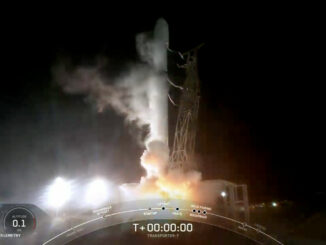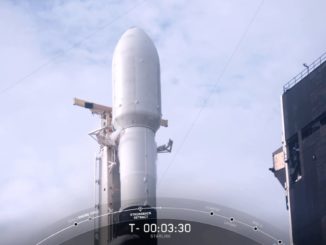
For the second time in a year, a large spent Chinese rocket stage intentionally left in orbit is heading for an unguided plunge back into Earth’s atmosphere Saturday or Sunday somewhere between 41.5 degrees north and south latitude.
The heavy-lift Long March 5B rocket stage took off April 28 with the Tianhe core module for China’s space station. The Long March 5B — one of the most powerful rockets in the world — tracked downrange to the southeast from the Wenchang launch base on Hainan Island, China’s southernmost province.
The launcher shed its four strap-on boosters about three minutes into the mission, but the two engines on the Long March 5B’s core stage continued firing for about eight minutes, doing all the work to place the 54.4-foot (16.6-meter) Tianhe space station module into orbit.
Most rockets have an upper stage to finish the job of deploying payloads into orbit. On those launchers, the first stage does not attain enough velocity to orbit the Earth. SpaceX recovers its first stages for reuse, while other launchers have booster stages that fall back to the ground hundreds of miles downrange from the launch site.
Many launch operators design their upper stages to reignite their engines at the end of their missions to guide the rockets to a controlled re-entry over a remote stretch of ocean. Rather than designing the huge Long March 5B core stage t0 remove itself from orbit using engines or thrusters, Chinese engineers left the rocket in space after finishing its mission.
The Long March 5B’s core stage has a mass of about 21.6 metric tons (23.8 tons) and measures about 98 feet (30 meters) long and 16 feet (5 meters) in diameter.
As of late Friday, the rocket was circling Earth in an orbit ranging in altitude between 92 miles and 145 miles (149-by-234 kilometers), according to U.S. military tracking data. The effects of aerodynamic drag from the upper layers of the atmosphere are gradually putting the brakes on the rocket’s velocity, which reduces the core stage’s altitude.
And the drag will only increase as the rocket gets closer to Earth. Some time Saturday or Sunday, the atmosphere will effectively capture the core stage when it no longer has the speed required to remain in orbit.
“The Long March 5B re-entry is unusual because during launch, the first stage of the rocket reached orbital velocity instead of falling downrange as is common practice,” the Aerospace Corp. said. “The empty rocket body is now in an elliptical orbit around Earth where it is being dragged toward an uncontrolled re-entry.”
The rocket will plunge back into atmosphere at nearly 17,000 mph (28,000 kilometers per hour), and most of the structure will burn up during re-entry. Friction generated from the rocket encountering air molecules will cause temperatures to build up to thousands of degrees.
But some fragments from the rocket could survive re-entry and fall back to Earth’s surface. While the rocket’s empty hydrogen and oxygen propellant tanks might burn up, denser components from the two main engines or strong pressure vessels could withstand the re-entry heating.
“The general rule of thumb is that 20–40% of the mass of a large object will reach the ground, but the exact number depends on the design of the object,” wrote Marlon Sorge, principal engineer at the Aerospace Corp.’s Center for Orbital and Re-entry Debris Studies. “In this case, we would expect about five to ten metric tons.
“Generally, for an upper stage, we see small and medium tanks survive more or less intact, and large engine components,” Sorge wrote. “The large tanks and the skin of this core stage are likely to come apart. We will also see lightweight material such as insulation fall out. The melting point of the materials used will make a difference in what remains.”
Exactly when and where the rocket will fall back into the atmosphere remained uncertain late Friday.
A forecast from the U.S. military’s 18th Space Control Squadron issued late Friday predicts the Long March 5B core stage will re-enter the atmosphere during a 12-hour period beginning around 11 p.m. EDT Saturday (0300 GMT Sunday).
The European Union’s Space Surveillance and Tracking Consortium said late Friday it expected re-entry of the Long March 5B between about 8:30 p.m. EDT Saturday and 8:30 a.m. EDT Sunday (0030-1230 GMT Sunday).

But uncontrolled re-entries are difficult to predict, and the forecast could change as ground-based radars continue tracking the Long March 5B rocket body in orbit. Changes in atmospheric drag and solar activity could move the time of re-entry earlier or later.
The error bars on the re-entry prediction will grow smaller as the time nears.
The rocket’s orbital track is inclined 41.5 degrees to the equator, meaning any debris from the rocket will fall in an area bounded by New York or Rome in the northern hemisphere, and Wellington, New Zealand, in the southern hemisphere.
“In this region, most part of the Earth surface is covered by ocean or uninhabited areas, so the statistical probability of an impact on the ground in populated areas is low,” the EU SST Consortium said. “These predictions however come with uncertainties as the object is uncontrolled, and a better estimation will only be possible a few hours before the actual re-entry.”
A one-minute error in predicting the re-entry time changes the location of potential falling debris by nearly 300 miles, or about 500 kilometers, according to the Aerospace Corp.
The consortium said the Long March 5B rocket stage is “one of the largest pieces of debris re-entering in the near past” and “deserves careful monitoring.”
“The probability that a piece of space debris will land on a city or a densely populated area is usually relatively small,” Sorge wrote. “What makes this re-entry particularly noteworthy is that it will occur between 41.5 deg N and 41.5 deg S latitudes, where the vast bulk of the world’s population lives.
“However, the statistical risk to any one person of being struck by falling space debris is so low that a colleague of mine jokes that if re-entry predictions put his house directly under the path, he’d go out with a camera and watch.”
The rocket’s plunge back to Earth this weekend is the second unguided re-entry of a massive Long March 5B core stage in less than a year.
The first launch of China’s Long March 5B rocket in May 2020 also left the core stage in orbit. The rocket dropped back into the atmosphere over the North Atlantic Ocean on May 11, 2020, minutes after a pass over the northern United States, including New York City.
Bits of wreckage from the Long March 5B rocket last year fell on Cote d’Ivoire, but no injuries were reported.
The Long March 5B core stage that re-entered the atmosphere last year was the most massive object to make an uncontrolled re-entry since the Soviet Union’s Salyut 7 space station in 1991, according to Jonathan McDowell, an astronomer at the Harvard-Smithsonian Center for Astrophysics who tracks global satellite and launch activity.
The Long March 5B core stage is more massive than other notable satellites that have plunged unguided back into Earth’s atmosphere in the last decade, such as China’s Tiangong 1 space lab, Russia’s failed Phobos-Grunt Mars probe, and NASA’s UARS atmospheric research satellite. It’s about one-quarter the mass of NASA’s Skylab space station, which made headlines when it fell to Earth over Australia in 1979.
Dead satellites and old rocket stages regularly re-enter the atmosphere, but re-entering objects with masses of more than a few tons are rare.
Additional Long March 5B rockets are set to launch new modules next year to assemble China’s space station. Unless China changes the design of the rocket’s core stage, there will be more uncontrolled rocket re-entry events after those missions.
Wang Wenbin, a spokesperson for the Chinese Foreign Ministry, said in a press conference Friday that it is “common practice” for upper stages of rockets to burn up while re-entering the atmosphere. He later incorrectly referred to the Long March 5B rocket body as an upper stage, and said that “most of its parts will burn up upon re-entry, making the likelihood of damage to aviation or ground facilities and activities extremely low.”
But no other launcher in the world leaves such a massive component to fall back to Earth in an uncontrolled manner.
“Controlled re-entries, particularly for a large object, require considerable planning and will have a significant impact on the design and payload capacity of the stage,” Sorge wrote. “Nevertheless, this is a preferred approach in international standards and is rapidly becoming a global norm.”
Email the author.
Follow Stephen Clark on Twitter: @StephenClark1.



